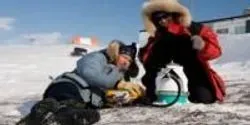Earth Science

The University of Washington research vessel Thomas G. Thompson is loading up for six weeks at sea. When the team returns to Seattle in late August they will have extended the cabling to key research sites, an important part of building the first real-time, continuous eye on the mysterious creatures, currents and geologic forms in waters off the Pacific Northwest coast.
| 4 min read

Scientists have created the first global topographic map of Saturn's moon Titan, giving researchers a valuable tool for learning more about one of the most Earthlike and interesting worlds in the solar system.
| 3 min read

New evidence from ancient lunar rocks suggests that the moon's long-lived dynamo -- a molten, convecting core of liquid metal that generated a strong magnetic field -- lasted 160 million years longer than originally estimated and was continuously active until well after the final large impacts.
| 2 min read

Researchers at Columbia Engineering and the Georgia Institute of Technology have published a study in the online Early Edition of the journal Proceedings of the National Academy of Sciences (PNAS) showing – for the first time – that certain volatile organic gases can promote cloud formation in a way never considered before by atmospheric scientists.
| 3 min read










